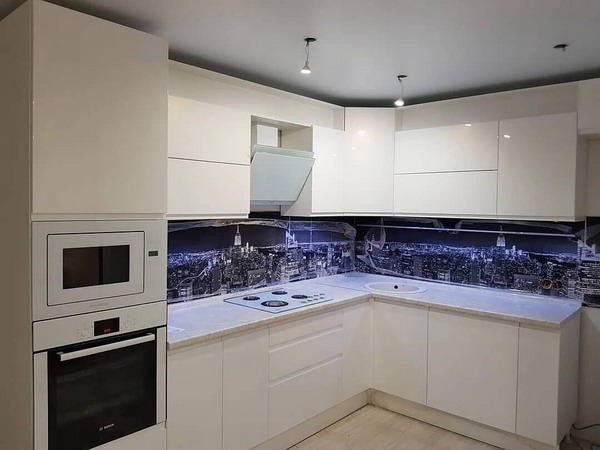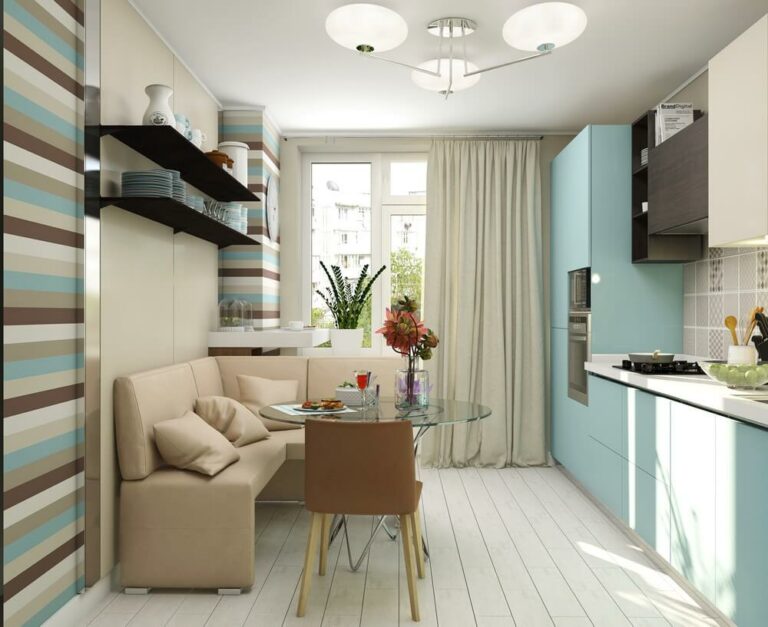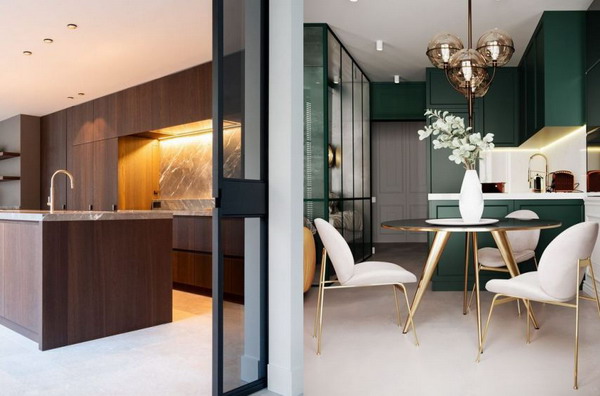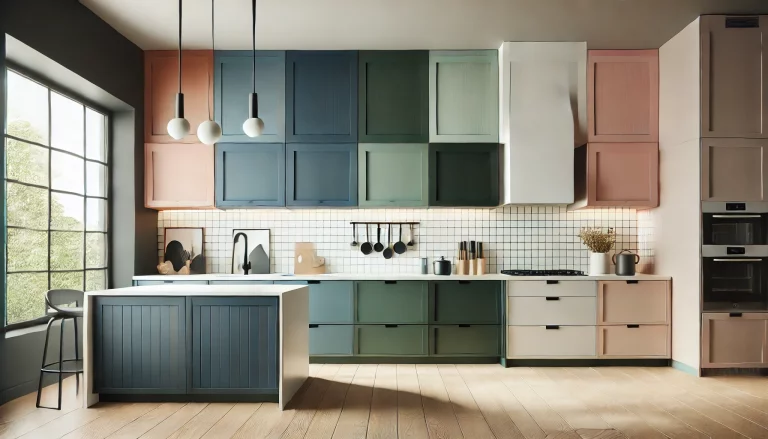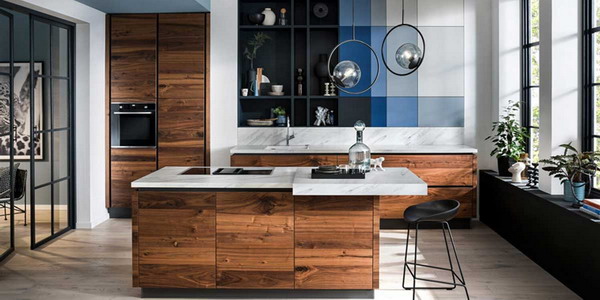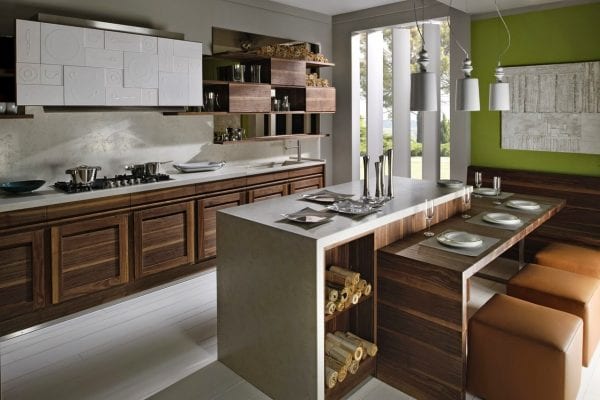How To Choose A Stretch Ceiling For The Kitchen
Is a suspended ceiling in the kitchen appropriate? The design, photos and recommendations in this article will help you decide!
You will find out what materials they are made of, which look is more practical for this room, which fixtures are more reliable, and also get specialist advice that will be very useful before going to the salon.
Contents
Who Invented The Suspended Ceilings?
Stretch ceilings have come into fashion relatively recently and many are simply afraid to get involved with innovative technologies, preferring conventional painting to all experiments. But in vain! They say correctly: “Everything is new – well-forgotten old” and the stretch ceiling is a direct confirmation of this.
For example, even in Ancient Egypt, Greece, Rome, Armenia, rich people covered the ceilings with silk and other fabrics. Gradually, the fashion came to naught, in particular because it was too expensive and short-lived.
And now the stretch fabrics have returned again, but not in the form of a silk coating, but in the form of a modern material, which is not only beautiful, but also quite practical. And it pleases that not only the rich can afford them, but ordinary people too!
Is It Worth It To Do In The Kitchen?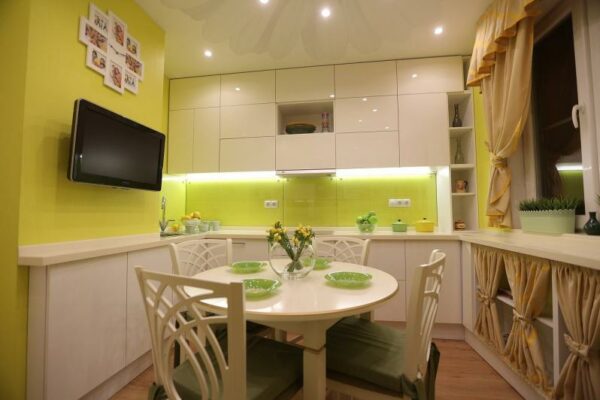
The kitchen is a peculiar room. There is increased moisture, and steam, and heat, and soot, and smells … Is it worth it to do a stretch ceiling and how long will it last, with such initial data?
For all the seeming unreliability, the stretch fabric, especially made of PVC, is quite durable and comfortable. Moreover, the kitchen is even larger than in other rooms.
Its main advantage is that it is washed, which means that you don’t have to tint every year the smoky places that are formed when using a gas stove.
Also, PVC stretch ceilings can save walls and floors in the event of a flood !
Such a coating as a plastic bag holds a huge amount of moisture, without letting it pass for a very long time. You just need to call the master and he will drain the water. But, in truth, after this the canvas will have to be replaced, since it cannot be restored after such a stretch.
He has several more advantages over ordinary ones, but there are also disadvantages.
In order to make it easier for you to compare and weigh all this, we offer a table in which we compare their characteristics.
So, which is better: stretch ceiling or plain painted:
| Tension | Painted |
| It looks very elegant and expensive. With it, you can emphasize the repair style.
That is, if you do not have such a goal and you want to focus on furniture or accessories, and not on the design of walls and ceilings, then you can do the usual, for painting. |
It is neutral and looks good only if the surface is perfectly flat. But on its smooth background beautiful chandeliers and other decorations look perfect.
To make interesting a painted ceiling can only a multi-level design, created using drywall, which is not very cheap. |
| Can be washed and wiped | Refreshed only by repainting |
| Protects furniture and walls from the flood | In case your neighbors flood you, not only the ceiling will spoil, but everything else in the kitchen |
| Less demanding on surface preparation and does not “steal” as much area around the perimeter as a suspension | Serious preparation of the draft ceiling is necessary for painting: first stripping, then puttying and finishing painting |
| Under the stretch ceiling, you can hide the wires, install spotlights, sound insulation | In order to hide communications on a normal ceiling, you need to ditch the walls, and for spotlights, make a suspended structure from drywall with subsequent painting |
As you can see, in order to get from a simple ceiling, as well as from a suspended ceiling, you need to invest a lot of money and in the end, it will work out that way.
The cheapest option is to lightly putty it and paint it. And in all respects it turns out that it is easier and more profitable to build a stretch ceiling if you want something original. But, not so simple! This is a superficial and initial comparison.
A lot depends on what type of stretch fabric you choose. And it’s worth talking in more detail.
But perhaps the most important thing: do not forget that the stretch ceiling is afraid of puncture and shock . Naturally, you won’t climb on the stepladder and intentionally puncture it, but a crazy cork from champagne can seriously ruin your mood and you will have to shell out for its restoration.
Types Of Stretch Fabric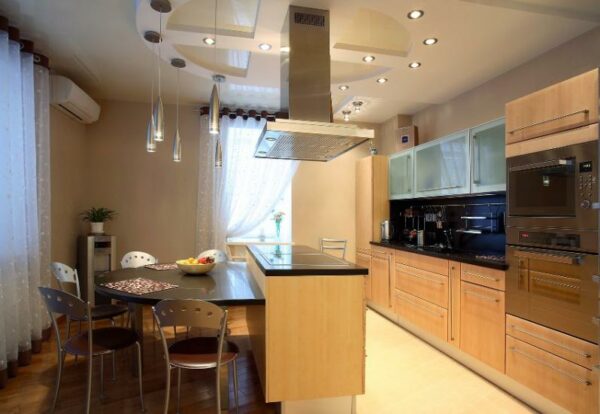
Now there are two types of ceiling coatings: fabric and film . And each of them also has its pros, cons and features.
Film (PVC) – are a little cheaper than fabric. There are matte, glossy, with a pattern.
They are easy to wash. Only film can retain moisture in the event of a flood !
But with this plus, they have a minus : if you have damp and constantly present high humidity, it is better to refuse them, since they absolutely do not breathe, which means that the fungus is just around the corner.
Cloth – look very expensive, leak moisture, they are also easy to care for. But the colors are slightly smaller and the maneuvers in the design are small. You can’t build a multi-level construction.
In order to facilitate the process of deciding which stretch ceiling is best for the kitchen, we have prepared a summary table. It indicates the main characteristics, pros and cons of each of these two coatings.
| Film (PVC) | Fabric |
| pros | |
| · More affordable than fabric
· Absolutely do not pass and do not absorb water, fat, condensate · Can be installed in rooms with high humidity · A huge range of colors, patterns, textures · They can be implemented both in simple forms and in complex multi-level structures · The ability to simulate stained glass, starry sky, abstract shapes |
· High Strength and Density
· Not afraid of temperature changes · Seamless tension · The elasticity of the fabric makes them more resistant to minor mechanical influences (scratches, brushing, etc.) · They look more comfortable and less artificially than film analogues |
| Minuses | |
| · Sensitive to temperature changes, especially abrupt. Recommended range is from +1 to +40
· Demanding in handling, you need to be very careful with them · With large areas of tension, joints can not do without · They look a bit unnatural, especially for glossy surfaces. |
· High cost
· Relative limited color solutions · Can absorb moisture, grease, dust · After several years, they may lose their former color saturation. · The fabric is highly responsive to any attempt to erase a stain or dirt. A pile appears, which at a certain angle of illumination can be very noticeable. |
Mat Or Gloss?
Arriving at the salon, customers often ask a question about the choice of texture: gloss or mat?
Here it’s up to you to decide what you like best. In our subjective opinion, the matte finish looks nobler and more expensive. This texture is suitable for interiors in classic styles, as well as for medium and large kitchens.
Gloss is a little more complicated. Firstly, color saturation is affected. It is one thing when it is a poisonous orange shiny ceiling, and the second – imitating a mirror surface or just white.
Secondly, the lighter the glossy canvas, the less noticeable the reflection. For example, on a black shiny surface you will clearly duplicate the entire interior. Believe me, this is not to everyone’s liking. Beige or blue, for example, is a more versatile option.
One thing is certain: if you decide on gloss, then we highly recommend combining it with a matte surface, for example, using the second level of a different texture.
Or, if there is no second level, then you should definitely repeat the glossy glare somewhere on the wall. Although, if you have shiny furniture in the kitchen that also reflects the surface, the combination will come out quite nice.
As for leaving and the difference between the surfaces, gloss is in the lead here. The matte surface is slightly rough, therefore, the ability to accumulate dirt on it more.
This is especially true for soot, which emit gas stoves. Therefore, if you do not have an electric oven, then the glossy option will be more practical.
Number Of Levels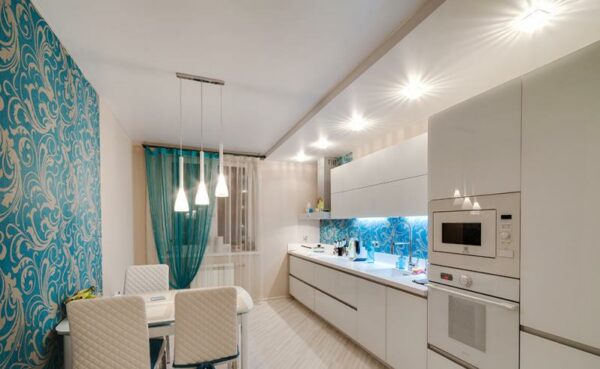
Frankly, this is far from the last fashion. Sophisticated designs are good in any cafes and entertainment complexes, and not in the living room.
The only design options that allow the use of two levels and do not look tasteless at the same time are the so-called “starry sky” and ceilings with photo printing.
The recommendation about not overloading the room with unnecessary motley is especially relevant for small kitchens. Even at 7-8 square meters, multi-level figures (also multi-colored!) Will look too fun. And in Khrushchev it’s not even fun, but sad.
Everything needs a measure, let’s say so. Where it is better to focus on kitchen accessories: paintings, lighting, textiles.
We offer you a small selection of ceiling design so that you can evaluate all this yourself and conclude:
Which Mounting System To Choose?
The method here is not one, but four. And you definitely need to understand them, since the future usability and durability of the coating depend on it.
As can be seen from the above diagram, there are four mounting methods:
- harpoon
- Wedge
- Shtapikovy
- Clipso
If you do not express to the installers your wishes regarding the type of fastening, then they will most likely choose the most comfortable and easiest way for themselves. And this does not mean at all that it will be beneficial for you either.
We will not get boring and explain on our fingers exactly how they “work”, everything is already visible in the picture. We’d better tell you what the pros and cons of these methods are for you, and what are the masters.
- Harpoon method – very good for you, as it involves easy dismantling and re-mounting in case of a flood.
But the masters do not like him very much, since in this case you need the most accurate calculation, up to a millimeter, great sleight of hand and speed. If there is an error during installation or cutting, then they will have to buy you a new one, taking off the whole team.
And as you know, non-professionals try to evade this method in every possible way, misleading you and passing off other methods as one that is the only one suitable for multiple installation. Therefore, carefully look at the picture and be on the alert!
- The Shtapikovy method is the dream of armless masters, despite the fact that this is the cheapest way.
But they have a maneuver and a reserve of 15-20 centimeters of cloth, which is not attached directly to the profile, but with the help of knocking glazing beads on the inner baseboard. Such ceilings are not subject to repair.
- The wedge method – also very loved by lay people. There are no calculations at all, the canvas is pulled literally “by eye”, which in the end can lead to sagging and uneven appearance. And as in the previous method – re-installation after the flood is excluded.
Some people choose cheaper methods consciously, for example, if they live in a high-rise building and they certainly do not threaten to be flooded. But they forget a simple thing: in addition to water under the ceiling, there is still wiring wherever your house is located. And if there is a short circuit or some other trouble with the electrician, you will have to say goodbye to the stretch ceiling.
- lipso method is an expensive and good method developed exclusively for fabric ceilings. It does not involve heating, re-installation is possible.
But, we do not recommend stopping on it if you don’t have special reasons for this: for example, the impossibility of heating the room with a hairdryer (plastic walls, for example). It is better to choose a harpoon method, it is cheaper and no worse. True, masters must be professionals.
In addition to the types of fastening, the types of profiles to which the web is mounted differ. They are aluminum and plastic.
The first, of course, is more expensive and better. Plastic is plastic, and it may one day crack, pulling the entire structure along with it. Or rather, on the contrary! The ceiling tension force is quite powerful, therefore, the profile has a large load, which never weakens. That is why it must be metallic.
Additional Recommendations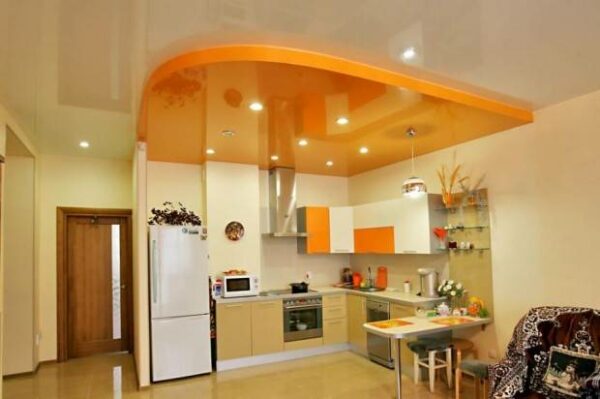
Also, the following tips can help you choose stretch ceilings in the kitchen:
- PVC surfaces, especially glossy ones, are best suited for kitchens designed in modern styles, such as high-tech. Fabric can look good in classic interiors;
- More often you will have to take care of film canvases, but at the same time they are easier to wash than fabric analogues (read more about how to wash stretch ceilings );
- Be sure to consult the manufacturer about the recommended power characteristics of the lighting elements;
- Never think about how to fix them yourself and thereby reduce costs.
Even if you have a special hairdryer or heat gun, nothing will work out for you, since here, in addition to the necessary equipment, you need skill and experience! Trying to save on this is not worth it, it will turn out to be more expensive. Just trust us and do not conduct experiments, which then will result in a significant amount.
Featured Manufacturers
We have selected for you a small list of reputable manufacturers, which, first of all, are well talked about by people.
We took information from the network: forums and sites of the type “questions and answers”, where you can always see unbiased reviews from live visitors.
- Barrisol
- Clipso
- Extenzo
- NewMat
- Carre Noir
These are European brands that did not disappoint and delight buyers for a long time. The rest that is on the market is Russian counterparts and everyone’s “beloved” China.
So, our article about the recommendation for choosing a stretch ceiling for the kitchen has come to an end. There is still a lot of information about this and we promise that we will supplement this article.
And, summing up the comparison of all the characteristics, we believe that the most suitable option for the kitchen are PVC surfaces. Only do not drink champagne there, please.
